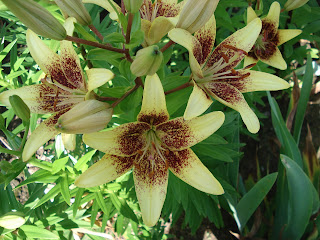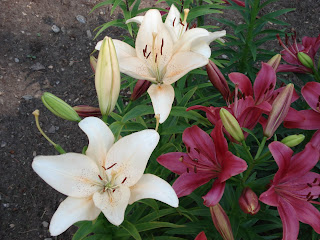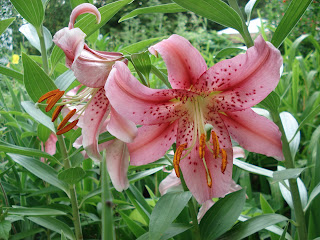 " " |
| Lighthouse beside "Purple Arctic Willow" Shrub and our waterfall |
 |
| Bog area with "Arrowhead" and mixed Irises |
 |
| Pond showing bog area and a few of our pale pink waterlilies |
 |
| "Jewell Weed" and "Morning Glories" |
I enjoy listening to the tranquil sounds of water cascading over our waterfall and slowly trickling it's way down the creek type pathway into the pond below. There is nothing as relaxing as sitting on the deck, watching the goldfish search for food and listening to the frogs serenade us with their own special tune. Our pond was originally built in 1991 and was about 10 by 12 feet and 34 inches deep. The original project was simply a pond on it's own as we didn't add the rest of the water features until later on in 1994. It is wise to use a good quality pond liner when you first start your pond. I have to admit that I did not use a good quality liner and had to replace it a few years later. Most garden centers carry these flexible liners as the backyard pond industry has grown to be an extremely popular one. Solid, custom made, formed ponds are also available in many shapes and sizes to suit any landscape design.
Every year I feel the urge to change or modify a few things mainly because the frost heaves many of the rocks surrounding the pond. Anyone who has a pond, whether a small, half barrel size or a larger, natural pond never seem to be quite satisfied with the look they have created. It is difficult not to keep moving things around but I think my pond is finally (maybe almost) just the way I want it. The pond now is about 12 by 16 feet but that is as big as it can ever be because it is fairly close to our house and we have simply run out of room. The bog area is 8 feet long by 3 feet wide.
A week or so after the lining and pond plants were in place and settled, we bought a dozen or so feeder goldfish about 2 to 3 inches long at the local pet store. Goldfish are valued for their many different colours as well as their adaptability to our growing conditions. We place our pond pump (used to run the waterfall in summer) into the pond with the attached hose just a few inches below the water surface during the winter months. This allows the water to bubble and keep the pond open about a foot in diameter. This helps the fish get enough oxygen to survive our Zone 4+ in South Eastern Ontario. Goldfish tend to grow to their environment and the size of the pond itself so they can reach up to 16 inches long. Most of our goldfish are about 8 to 10" long.
We added some pretty, pale pink waterlilies the first year then purchased a beautiful salmon coloured lily called "Cherokee" a few years later. They are a gorgeous addition to any pond but be warned that they will have to be split after 3 or 4 years. I have tried a few different ways to grow waterlilies in different size pots but they outgrow them too quickly. Just a plain, plastic kitty litter type of container has worked out the best for me. I also use 24" plastic window boxes with great success. I place small, rounded stones in the very bottom then add the lily roots. I cover the roots with a fairly heavy soil that has quite a bit of clay then place some round stones over the soil to keep it from washing away. I had a few "Bulrushes" for the first few years but they got to be too much for my small pond as they are quite invasive.
In 1996 we added the waterfall and a small stream that trickles down to the pond. I wanted to have a small bog area where I could enjoy some of the interesting plants that are moisture loving. My "Marsh Marigolds" with their bright yellow flowers and shiny, rounded leaves are the first to show off their intense colour in spring. I have had good luck with "Astilbe plants, "Joe Pye", "Flowering Rush", "Blue Lobelia" and a bit of "Creeping Jenny". I love the many different colours and varieties of Iris that thrive in the bog garden. Blue/mauve wild irises, and multi coloured Siberians have narrow, sword-like leaves and showy flowers that bloom from mid-spring to mid-sumer. My tall, yellow irises have variegated yellow and green leaves and are a real showpiece. A bog is a wonderful addition to the edge of the pond but remember to keep the water in the two bodies from mixing as the bog needs to be slow draining.
In 1996 we added the waterfall and a small stream that trickles down to the pond. I wanted to have a small bog area where I could enjoy some of the interesting plants that are moisture loving. My "Marsh Marigolds" with their bright yellow flowers and shiny, rounded leaves are the first to show off their intense colour in spring. I have had good luck with "Astilbe plants, "Joe Pye", "Flowering Rush", "Blue Lobelia" and a bit of "Creeping Jenny". I love the many different colours and varieties of Iris that thrive in the bog garden. Blue/mauve wild irises, and multi coloured Siberians have narrow, sword-like leaves and showy flowers that bloom from mid-spring to mid-sumer. My tall, yellow irises have variegated yellow and green leaves and are a real showpiece. A bog is a wonderful addition to the edge of the pond but remember to keep the water in the two bodies from mixing as the bog needs to be slow draining.
One of my favourite floating plants is the "Water Hawthorn" as it produces long, floating leaves from a submerged tuber. Fragrant white flowers stand just above the water and bloom on and off from May until mid September. They are planted in fairly large pots and sit on a ledge along the side of the pond. We put "Parrot's Feather", an oxygenating perennial in the small holding tank at the top of the waterfall and also along the stream and trailing into the pond. "Parrot's Feather" is a prolific growing plant so there is always lots to share with other pond loving friends. It's green, feathery foliage rises several inches above the water surface. Their roots provide a wonderful spawning area for our goldfish. "Arrowhead" plants are grown in submerged pots along the ledge at the sides of the pond and can also be planted in the bog. Their pretty, apple blossom type flowers bloom for weeks. I also have an interesting foliage plant, growing in a submerged pot, whose leaves look like spruce tree branches, but are very soft. I am unsure of it's name but usually have extra pieces to share with friends every spring.
 |
| "Cherokee" Water Lily |
Oxygenating or submerged plants are critical to your pond as they help reduce algae by taking up carbon dioxide and releasing oxygen to plants and fish too. One bunch per square foot of water surface is sufficient. Fish love to hide and spawn in among these plants. There are numerous tropical plants that can be grown in your pond but they must be removed before the first frost. I keep my pretty, potted "Black Taro" plant indoors, under lights in a shallow tray over the winter.
Raccoons, Blue Herons and Kingfishers are a few of the unwelcome predators who attempt to go after the goldfish. I have had a few encounters with the odd garter snake going after small frogs or small fish but only a few times over the years. The frogs, toads and fish all help keep the mosquito population down. I wish they could do the same thing with our pesty black flies.
It would be wise to check your local building codes and zoning regulations regarding putting in a pond on your property. It is best to avoid unpleasant surprises. I hope you enjoy your pond as much as we have for the past 20 years.
Raccoons, Blue Herons and Kingfishers are a few of the unwelcome predators who attempt to go after the goldfish. I have had a few encounters with the odd garter snake going after small frogs or small fish but only a few times over the years. The frogs, toads and fish all help keep the mosquito population down. I wish they could do the same thing with our pesty black flies.
It would be wise to check your local building codes and zoning regulations regarding putting in a pond on your property. It is best to avoid unpleasant surprises. I hope you enjoy your pond as much as we have for the past 20 years.






























